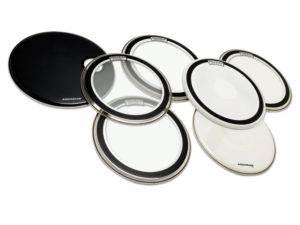Drum Heads
 Drumming is a vital part of a band’s sound and demands great tone and power and a close feel for what you’re doing. The drum heads you use are a critical choice as it is responsible for both of these aspects of drumming. With durable heads on your drums, you can be sure that they’ll deliver the amazing feel and sound that you rely on every time you practice or take the stage.
Drumming is a vital part of a band’s sound and demands great tone and power and a close feel for what you’re doing. The drum heads you use are a critical choice as it is responsible for both of these aspects of drumming. With durable heads on your drums, you can be sure that they’ll deliver the amazing feel and sound that you rely on every time you practice or take the stage.
Make your Drum Kit sound Amazing
Whether your drum kit has a single-ply head, a double-ply head, a coated head, or a clear head, the proper tuning and maintenance can make your drum kit sound amazing.
Changing the drum heads (also known as skins) regularly is one of the most important things to do. Eventually, everyone will need to change their drum head whether you play the drums once a week, or once a day. Being the main striking point on the drum set, they need to remain tight in order to keep the best sound.
How do Drum Heads Work?
A drum head works the best when the tension on the skin is even all around. In time, the skin will eventually weaken where you strike it the most, causing the tension to change. A weaker skin is more likely to dent, or even puncture with harder hits. In addition, a weaker skin will have little rebound for your stick.
When to change your Drum Heads?
As a general rule of thumb, most skins should be changed every six months. If you play your set a lot you may need to change it more frequently. Some things to look for in skins are indents and cracks. If you have a lot of bumps on your skin, chances are it will sound out of tune and need changing. Stick marks on the heads are ok, as long as there is no damage, a few marks will not hurt it. With your bass drum head, make sure you are not digging a hole right where your beater hits, or a patch may be needed.
Snare Drum Heads
Your snare drum heads usually need to be changed twice as often as your tom heads as most drummers play the snare harder and more often than the toms. A good way to tell if your snare head needs replacing is by pressing down in the middle of the snare. Check and see if it droops or is weaker there than around the rim. Another way is to take the snare off and hit the center of the drum. If it sounds muffled or short, chances are it is time to change it.
